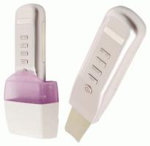Treatment cosmetology
Cosmetology (from Greek kosmētikos, "beautifying") is the study of rational body care (skin care cosmetology) and the art of camouflaging skin imperfections and beautifying (beautifying cosmetology).
Treatment cosmetology prevents skin diseases and helps to remove skin defects. It supports dermatological therapies (both treatment and pharmacological).
Treatments applied in treatment cosmetology:
- microdermabrasion,
- chemical peelings,
- cavitation peeling,
- sonoforesis,
- iontophoresis,
- thermotherapy (the application of heat or cold),
- laser biostimulation,
- application of preparations containing active ingredients appropriately matched to the skin problem (ampoules, serums, creams, masks, etc.);
Microdermabrasion - a technique of mechanical peeling of the epidermis, layer after layer. It involves abrasion of epidermal layers with a special device equipped with handpieces covered with natural diamond crystals. Removal of skin cells from the top layers of the epidermis enhances intensive production of new cells. The exfoliation is a gradual process, performed under professional supervision, therefore there is no risk of too deep or uneven exfoliation and scarring. Moreover, microdermabrasion machines have integrated vacuum pump, offering additional massage, stimulating the treated skin to increased synthesis of collagen and elastin, which results in thicker and firmer skin. Thanks to these effects, the therapy is widely used for skin rejuvenation, correction of wrinkles and scars, elimination of discolouration spots, cleansing skin and the treatment of acne.
Chemical peelings - the effect of epidermis cells' exfoliation, collagen stimulation and whitening of discolouration spots is obtained as an effect of application of chemical solutions (alpha and/or beta hydroxy acids) on the skin.
In our cosmetic treatments we offer professional use peelings by Spanish Mediderma and French Filorga laboratories:
 Cavitation peeling - is a phenomenon of formation of microscopic gas bubbles as a consequence of ultrasounds applied on moist skin. The action causes an immediate pressure change and a series of processes leading to the breakdown of dead cells of stratum corneum.
Cavitation peeling - is a phenomenon of formation of microscopic gas bubbles as a consequence of ultrasounds applied on moist skin. The action causes an immediate pressure change and a series of processes leading to the breakdown of dead cells of stratum corneum.
Advantages of the treatment:
- painlessly and and thoroughly cleanses and disinfects the skin of the face, neck and upper chest
- removes dead skin cells and comedones
- clears skin pores from excess sebum, bacteria and metabolites
- complements treatment of acne
- prepares skin for further facials
- regenerates skin and muscles of facial expression
- eliminates wrinkles, leaving a smooth, flexible and refreshed skin
- stimulates microcirculation
- whitens discolouration
- enhances cell metabolism
- moisturises deeply by introducing micronized water into the skin
Sonoforesis - by means of special devices emitting ultrasonic waves, active substances supporting the treatment of dermatoses and skin care are introduced deep into the skin. The effect of sonication on the skin causes an increase in cell membrane permeability, cell metabolism activation and increased cell respiration. The ultrasonic vibrations act on the deeper layers of the skin like a biostimulating micromassage. Micricirculation and lymphatic flow improve, the PH level of acidic tissues increases. Fibroblasts get stimulated to the biosynthesis of collagen and elastin.
The effects of ultrasounds on the skin:
- generate heat, which improves the circulation of blood and lymph, relaxes muscles, enhances cell metabolism
- assist in penetration and absorption of medicines and cosmetics through the skin
- accelerate cell regeneration
- reduce swellings and oedema
- help to smooth wrinkles
- exfoliate the epidermis
- inhibit inflammatory disorders, help in heeling and regenerating wounds
- increase skin hydration
- support acne therapy, reduce skin pores
- give the skin healthy brightness and a fresh appearance
Iontophoresis - a treatment administering medicine ions transcutaneously, using constant galvanic current. Iontophoresis may involve chemical compounds which undergo electrolytic dissociation, so the particles split into positive or negative ions. The treatment effect is a synergy of medicine and galvanization. We use the technique in the cases, when we want to obtain anti-inflammatory and analgesic action or relax muscles. In the treatment cosmetology iontophoresis is recommended for patients with: dilated capillaries, angioneurosis, cold injuries, common acne, rosacea, skin flaccidity, scars, keloids and allergies.
Contraindications to ionto- and sonophoresis therapies:
- pregnancy
- heart pacemaker
- skin cancers
- some skin allergies and disorders in their active phase
Thermotherapy - is a general term for treatment with heat or cold, depending of the applied physical medium. Physically, it means the application, relatively taking back the thermal energy from an organism. Despite the differences in physiological action, the therapeutic effects of the application of either heat or cold are similar. They lead to reducing the intensity of pain, muscle relaxation and inhibition of inflammatory process. In case of acute exThighstive reaction, a therapy with cold is applied, while in chronic inflammatory process - heat therapy.
The influence of heat and cold on motor organs
| HEAT | COLD | |
|---|---|---|
| blood vessels | vasodilation | vasoconstriction |
| connective tissue | increased flexibility | decreased flexibility |
| muscles | automatic relaxation | relaxation as an effect of decreased activity of muscle spindles |
| cell metabolism | metabolism increase | metabolism decrease |
| inflammation | increase/suppression | suppression |
General indications to treatment with heat
Indications for the application of heat comprise particularly chronic inflammatory disorders of various etiologies, where it is possible to obtain a possitive effect as a result of active hyperaemia. In patients with skin diseases heat therapy is used for the treatment of acute inflammatory conditions (acne, furunculosis).
Lowering the temperature of tissues causes:
- pain reduction or relieve,
- inhibition of inflammatory disorders,
- slowing down the metabolic processes,
- reduction or elimination of oedema,
- relaxation of reflexes and reduction of excitability of nerve fibres,
- vasoconstriction and their periodic extension, active hyperaemia,
- increase of muscle tone (with a short duration of the cold stimulus) and decrease of muscle tone (with a longer exposure to the cold stimulus).

